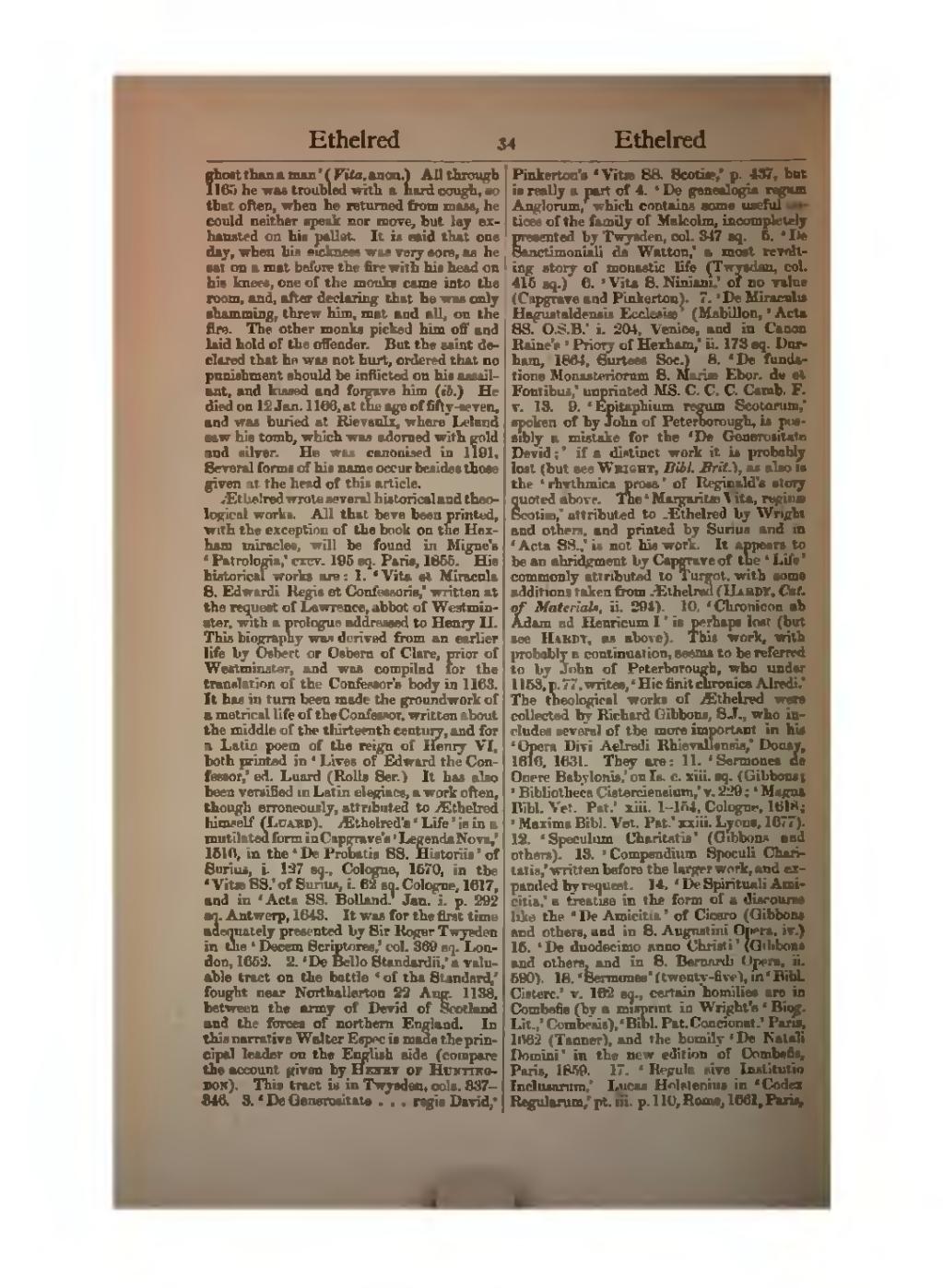ghost than a man’ (Vita, anon.). All through 1165 he was troubled with a hard cough, so that often, when he returned from mass, he could neither speak nor move, but lay exhausted on his pallet. It is said that one day, when his sickness was very sore, as he sat on a mat before the fire with his head on his knees, one of the monks came into the room, and, after declaring that he was only shamming, threw him, mat and all, on the fire. The other monks picked him off and laid hold of the offender. But the saint declared that he was not hurt, ordered that no punishment should be inflicted on his assailant, and kissed and forgave him (ib.) He died on 12 Jan. 1166, at the age of fifty-seven, and was buried at Rievaulx, where Leland saw his tomb, which was adorned with gold and silver. He was canonised in 1191. Several forms of his name occur besides those given at the head of this article.
Æthelred wrote several historical and theological works. All that have been printed, with the exception of the book on the Hexham miracles, will be found in Migne's ‘Patrologia,’ cxcv. 195 sq. Paris, 1855. His historical works are: 1. ‘Vita et Miracula S. Edwardi Regis et Confessoris,’ written at the request of Lawrence, abbot of Westminster, with a prologue addressed to Henry II. This biography was derived from an earlier life by Osbert or Osbern of Clare, prior of Westminster, and was compiled for the translation of the Confessor's body in 1163. It has in turn been made the groundwork of a metrical life of the Confessor, written about the middle of the thirteenth century, and for a Latin poem of the reign of Henry VI, both printed in ‘Lives of Edward the Confessor,’ ed. Luard (Rolls Ser.) It has also been versified in Latin elegiacs, a work often, though erroneously, attributed to Æthelred himself (Luard). Æthelred's ‘Life’ is in a mutilated form in Capgrave's ‘Legenda Nova,’ 1516, in the ‘De Probatis SS. Historiis’ of Surius, i. 127 sq., Cologne, 1570, in the ‘Vitæ SS.’ of Surius, i. 62 sq. Cologne, 1617, and in ‘Acta SS. Bolland.’ Jan. i. p. 292 sq. Antwerp, 1643. It was for the first time adequately presented by Sir Roger Twysden in the ‘Decem Scriptores,’ col. 369 sq. London, 1652. 2. ‘De Bello Standardii,’ a valuable tract on the battle ‘of the Standard,’ fought near Northallerton 22 Aug. 1138, between the army of David of Scotland and the forces of northern England. In this narrative Walter Espec is made the principal leader on the English side (compare the account given by Henry of Huntingdon). This tract is in Twysden, cols. 337–346. 3. ‘De Generositate … regis David, Pinkerton's ‘Vitæ SS. Scotiæ,’ p. 437, but is really a part of 4. ‘De genealogia regum Anglorum,’ which contains some useful notices of the family of Malcolm, incompletely presented by Twysden, col. 347 sq. 5. ‘De Sanctimoniali de Watton,’ a most revolting story of monastic life (Twysden, col. 415 sq.). 6. ‘Vita S. Niniani,’ of no value (Capgrave and Pinkerton). 7. ‘De Miraculis Hagustaldensis Ecclesiæ’ (Mabillon, ‘Acta SS. O.S.B.’ i. 204, Venice, and in Canon Raine's ‘Priory of Hexham,’ ii. 173 sq. Durham, 1864, Surtees Soc.). 8. ‘De fundatione Monasteriorum S. Mariæ Ebor. de et Fontibus,’ unprinted MS. C. C. C. Camb. F. v. 13. 9. ‘Epitaphium regum Scotorum,’ spoken of by John of Peterborough, is possibly a mistake for the ‘De Generositate David;’ if a distinct work it is probably lost (but see Wright, Bibl. Brit.), as also is the ‘rhythmica prosa’ of Reginald's story quoted above. The ‘Margaritæ Vita, reginæ Scotiæ,’ attributed to Æthelred by Wright and others, and printed by Surius and in ‘Acta SS.,’ is not his work. It appears to be an abridgment by Capgrave of the ‘Life’ commonly attributed to Turgot, with some additions taken from Æthelred (Hardy, Cat. of Materials, ii. 294). 10. ‘Chronicon ab Adam ad Henricum I’ is perhaps lost (but see Hardy, as above). This work, with probably a continuation, seems to be referred to by John of Peterborough, who under 1153, p. 77, writes, ‘Hic finit chronica Alredi.’ The theological works of Æthelred were collected by Richard Gibbons, S.J., who includes several of the more important in his ‘Opera Divi Aelredi Rhievallensis,’ Douay, 1616, 1631. They are: 11. ‘Sermones de Onere Babylonis,’ on Is. c. xiii. sq. (Gibbons; ‘Bibliotheca Cisterciensium,’ v. 229; ‘Magna Bibl. Vet. Pat.’ xiii. 1–154, Cologne, 1618; ‘Maxima Bibl. Vet. Pat.’ xxiii. Lyons, 1677). 12. ‘Speculum Charitatis’ (Gibbons and others). 13. ‘Compendium Speculi Charitatis,’ written before the larger work, and expanded by request. 14. ‘De Spirituali Amicitia,’ a treatise in the form of a discourse like the ‘De Amicitia’ of Cicero (Gibbons and others, and in S. Augustini Opera, iv.). 15. ‘De duodecimo anno Christi’ (Gibbons and others, and in S. Bernardi Opera, ii. 590). 16. ‘Sermones’ (twenty-five), in ‘Bibl. Cisterc.’ v. 162 sq., certain homilies are in Combefis (by a misprint in Wright's ‘Biog. Lit.,’ Combesis), ‘Bibl. Pat. Concionat.’ Paris, 1662 (Tanner), and the homily ‘De Natali Domini’ in the new edition of Combefis, Paris, 1859. 17. ‘Regula sive Institutio Inclusarum,’ Lucas Holstenius in ‘Codex Regularum,’ pt. iii. p. 110, Rome, 1661, Paris,
